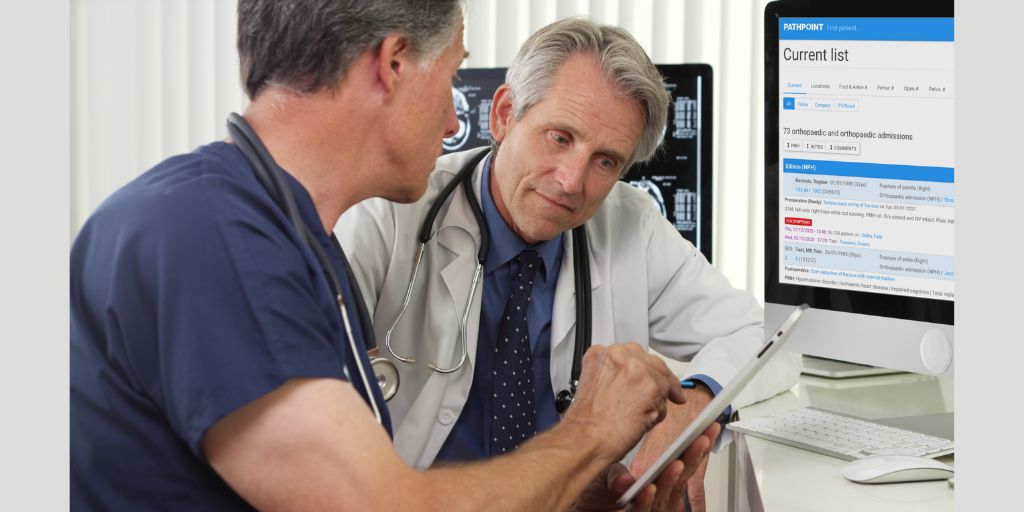
Scotland’s Health and Social Care Data Strategy has an ambitious vision of empowering individuals and providers with timely access to high-quality data, and the key to realising this vision lies in digital solutions. NHS Ayrshire and Arran’s Trauma and Orthopaedics (T&O) department adopted Pathpoint eTrauma, a cloud-based platform for trauma workflow management. To obtain valuable insights on the use of digital solutions in healthcare, particularly in trauma care, Open Medical conducted an interview with two key figures at the hospital: Mr. Andy Tanagho and Gillian Evans. During the interview, it became clear that access to information is a major topic, aligning with Scotland’s healthcare data strategy to make “fit-for-purpose data readily accessible.”
Readily accessible
Gillian Evans, Assistant General Manager in T&O and Operational Manager for the service, says that easy access to patient data improved visibility. She explains that prior to eTrauma, “that information would be on a piece of paper somewhere or in someone’s pocket. So [eTrauma] gives that full picture of everything.”
Efficiency
Gillian also adds that easier access increases efficiency, “looking through sets of case notes is a laborious task, it adds time, makes it inefficient. So if you have easy access to digital information about patients, you can make your decisions faster, you know much more about the patient, everything is at your fingertips.”
Structure
With greater data access and visibility, structure and organisation follow. Mr. Andy Tanagho, Consultant Orthopaedic Surgeon and Clinical Director of Trauma Services explains that eTrauma helped organisation-wise, “eTrauma helped with trauma management in all its aspects. (…) It’s more organised. Being able to flag, for instance, your post-operative patients on a specific day. Being able to plan theatre sessions ahead of time. (…) You have alert systems or tag systems, notifications.”
Communication
Improved accessibility leads to better collaboration and communication, indirectly improving patient outcomes. Gillian says that if a patient were to complain, “I know that interaction will be recorded somewhere, and you can then go speak to the team and find out what happened with that patient.” Andy also mentions that “communicating with patients is much easier now and updated live as you go. So it improves the communication between staff members, which ultimately improves your outcomes.”
Fit for purpose
The importance of high-quality data cannot be overstated, it must be fit-for-purpose. In order for healthcare providers to use data effectively, it must be consistent and structured, and Andy Tanagho states, “[eTrauma] has an audit trail to know who’s done what and who updated what.” Additionally, eTrauma provides access to granular data, including specialty-specific clinical data, which can offer highly relevant information that can enable healthcare providers to make more informed decisions and deliver more personalised care to patients based on their unique needs. Without high-quality data, the benefits of greater access are lost, so it’s crucial to focus on ensuring that the data is fit-for-purpose.
Standardisation
Scotland’s healthcare data strategy places a strong emphasis on the importance of interoperability in improving information standards. At present, eTrauma is integrated with TrakCare at NHS Lanarkshire as well as many other systems across the NHS, and NHS Ayrshire and Arran are keen to follow suit with the support of Open Medical. Gillian Evans says they are “absolutely up for that integration, and we want it to happen.” Integrating these systems will enable more consistent information standards across their healthcare systems, a significant step towards achieving Scotland’s digital healthcare goals.
Unlocking the possibilities
Digital solutions can unlock the immense potential of NHS Scotland. Solutions with standardised, granular data-capture that is easily accessible must be implemented to obtain data-driven insights. With the power of digital transformation solutions, we can ensure that the right care is delivered at the right time at the right place. As Gillian Evans aptly said, “Everything is at your fingertips.” By embracing digital solutions, the future of health and social care can be achieved sooner than we think.








